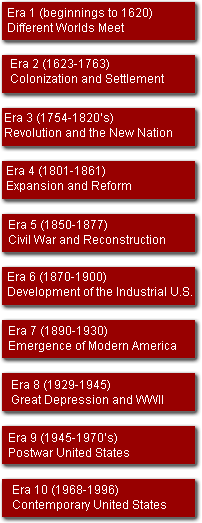 |
 |
|
|
 |

ERA 9 HIGHLIGHTS IN NEW HAMPSHIRE: Cold War, returning soldiers, woman's place, middle class ideals, the consumer culture, conservative politics, the tax question, dissension of the 1960s The big themes of this era center on the fears and hopes of post-war politics, economics, and technology set against a background of the atomic bomb and a growing mass consumer culture. During the 1950s. New Hampshire
was still finding out how national and international trends and forces
would play out in the state. New Hampshire took part in the postwar economic
boom. Soldiers cam
The home became the center
of consumerism. Household gadgets and appliances defined the modern household.
While the ideal had the appearance of a consensus view, many individuals
and families
Nonwhites in the state increased during the 1950s, until by 1960 there were 2,587, partially because of members of the armed forces at Pease Air Force Base. By 1970, the nonwhite population was 4575 and 2505 of those were black in a total population of 737,681. The economic profile of New
Hampshire changed. Once textiles had been the industrial backbone of the
state, but now small manufacturing and electronics firms moved into the
forefront in a resurgence of industry. Agriculture began an almost unnoticed
rebirth with organic farming that would take thirty years to develop. Tourism
grew to become a major part of the New Hampshire economy. Automobiles on
improved roads moved tourists and sports enthusiasts to and from the state.
Recreational visits became shorter and more frequent, unlike the extended
sojourns of the nineteenth century, and this demanded different kinds of
In politics, the Cold War
reached into the state and New Hampshire became a kind of conservative
bell-weather. William Loeb bought the Manchester Union Leader in 1946;
as owner and editor of the only statewide New Hampshire newspaper, Loeb
achieved a national reputation as the irascible conservative voice
New Hampshire state politics kept a conservative Republican cast. The New Hampshire legislature created a commission in 1949 to investigate Communist activities in the state. In 1951 the legislature passed a Subversive Activities Act. Under the umbrella of this act, Louis Wyman, as New Hampshire Attorney General from 1953-1961, with the public support of the Manchester Union Leader, headed a government search to ferret out Communist sympathizers in the state. In the same decade. New Hampshire's first-in-the- nation presidential preference primary quickly became a national political barometer. Cracks appeared in the public
persona of the state, however. Issues such as what kind and quantity of
taxes would pay for local schools arose every election year. In addition,
nation-wide movements in the 1960s -Civil Rights, women's rights, peace,
rock music, and flower children - chipped away at what some declared to
be the New Hampshire way of die-hard conservatism.
|